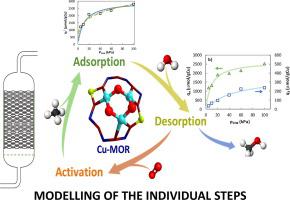Chemical Engineering Science ( IF 4.1 ) Pub Date : 2022-06-22 , DOI: 10.1016/j.ces.2022.117818 Mauro Álvarez , Pablo Marín , Salvador Ordóñez

|
The interest in methane direct conversion into methanol has increased in the last years. A copper-mordenite looping process, based on the separation of methanol formation (200 °C) and copper re-activation (450 °C), has been studied. Methane partial pressure (studied in the range 5–100 kPa) had a positive effect on methanol productivity (10.7 μmol/g zeolite at 100 kPa CH4). It was found that the adsorption time had some impact on the productivity; a minimum value of 60 min was needed to reach the equilibrium. Using the experimental results, the equilibrium and kinetics of methane chemisorption were modelled. The proposed model is based on the formation of two adsorbed species: methoxy and CO2-precursors.
Many methane emissions and feedstocks are diluted and contain oxygen. Thus, methane adsorption has also been studied at aerobic conditions, to apply the looping conversion of methane into methanol to these sources. High oxygen concentrations were considered (2.5–16 mol%), resulting in a decrease in methanol productivity and the over-oxidation of most adsorbed CO2-precursors during the adsorption step. The model was updated for considering the over-oxidation to CO2.
中文翻译:

通过铜沸石上的化学循环升级甲烷排放:实验和建模
在过去几年中,人们对甲烷直接转化为甲醇的兴趣有所增加。已经研究了基于甲醇形成(200°C)和铜再活化(450°C)分离的铜丝光沸石循环工艺。甲烷分压(研究范围为 5-100 kPa)对甲醇生产率有积极影响(100 kPa CH 4时为 10.7 μmol/g 沸石)。发现吸附时间对产率有一定影响;达到平衡至少需要 60 分钟。利用实验结果,对甲烷化学吸附的平衡和动力学进行了建模。所提出的模型基于两种吸附物质的形成:甲氧基和CO 2前体。
许多甲烷排放物和原料被稀释并含有氧气。因此,甲烷吸附也在有氧条件下进行了研究,以将甲烷循环转化为甲醇应用于这些来源。考虑到高氧浓度(2.5-16 mol%),导致甲醇生产率下降和吸附步骤中大多数吸附的 CO 2前体的过度氧化。更新了模型以考虑到 CO 2的过氧化。











































 京公网安备 11010802027423号
京公网安备 11010802027423号